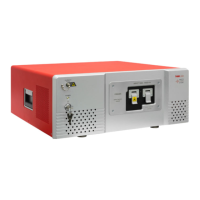Redstone™ Optical Spectrum Analyzer Chapter 4: Description
Rev C, January 21, 2022 Page 4
Chapter 4 Description
The Thorlabs Optical Spectrum Analyzer (OSA) is a general-purpose spectrum analyzer for optical research
and production applications. It has a user-friendly Graphical User Interface and can be controlled from a
standard PC via a High Speed USB port. Each instrument offers an FC/PC fiber input receptacle and a free-
space input for collimated beams. Special designs with other input receptacles are available on request. The
instrument is designed for measurements of continuous wave (CW) light sources, but works in some
applications where pulsed light is used. Please contact Technical support at techsupport@thorlabs.com to
discuss your application if you have a pulsed source.
4.1. Introduction
Thorlabs’ Optical Spectrum Analyzers are general-purpose instruments that measure optical power as a
function of wavelength. These OSA instruments are versatile enough to analyze broadband optical signals,
resolve the Fabry-Perot modes of a gain chip, and identify gas absorption lines in a spectral measurement.
Whereas commonly available OSAs are typically grating-based monochromators, the Thorlabs instruments are
Fourier Transform Optical Spectrum Analyzers (FT-OSAs), which utilize a scanning Michelson interferometer
design, as shown in Figure 1. This approach allows for the design of a full-featured OSA with the additional
benefit of a high-precision wavelength meter.
Thorlabs offers two lines of analyzers, including the OSA20xC models and the Redstone OSA305 model. The
Redstone OSA305 is a more advanced instrument for demanding applications that require a higher optical
resolution or sensitivity whereas the OSA20xC instruments are general-purpose analyzers with moderate
resolution and high update rate.
The Thorlabs Redstone FT-OSA has an FC/PC-style optical fiber input and a free-space input. After collimating
the input light, a beamsplitter divides the optical signal into two separate branches. The path length difference
between the two branches is varied up to a maximum of 160 mm. The collimated light fields then optically
interfere as they recombine at the beamsplitter. The detector units shown in Figure 1 record the interference
pattern, which is commonly referred to as an interferogram. This interferogram is the autocorrelation waveform
of the input optical spectrum. By applying Fourier transform to the waveform, the optical spectrum is recovered.
The resulting spectrum offers both a high resolution and a very broad wavelength coverage with a spectral
resolution that is related to the optical delay range. The wavelength range is limited by the bandwidth of the
detectors and the optical coatings. Furthermore, the accuracy of our system is ensured by including an infrared
frequency-locked reference laser. The reference lasers provide highly accurate measurements of optical path
length changes, allowing the system to continuously self-calibrate. This process ensures accurate optical
analysis well beyond what is possible with a grating-based OSA.
4.2. Interferometer Design
The Redstone OSA uses a standard arrangement of one fixed and one movable retroreflector as shown in
Figure 1. The mobile retroreflector is mounted on a voice-coil-driven platform, which changes the optical path
length of the branch. The fixed retroreflector is mounted on a piezo actuator that translates the retroreflector in
the two dimensions orthogonal to the beam path in a self-alignment algorithm. This configuration changes the
optical path difference (OPD) between the two branches by twice the mechanical movement of the platform.
The Redstone OSA collects single-sided interferograms, which are asymmetrical in terms of the location of the
point of zero path difference (ZPD), which is located significantly closer to one end of the stroke.
The Redstone OSA305 has a 80 mm stroke length capacity, and thus a maximum OPD of 160 mm and a
spectral resolution of 2.0 GHz or 0.0625 cm
-1
. The wavelength resolution is dependent on the wavelength of
light being measured. For more details see Section 4.7 Resolution and Sensitivity. In this context, the spectral
resolution is defined according to the Rayleigh criterion and is the minimum separation required between two
spectral features in order to resolve them as two separate lines. These spectral resolution numbers should not
be confused with the resolution when using the Wavelength Meter or Peak Track tools, which is considerably
better.
The Thorlabs OSAs utilize a built-in, actively stabilized reference laser to interferometrically record the variation
of the optical path length. This reference laser is inserted into the interferometer and closely follows the same
path traversed by the unknown input light field. To reduce the effects of water absorption on the acquired
spectrum, our OSAs have two 1/4" inner-diameter quick-connection hose fittings on the back panel, through
which the interferometer can be purged with dry air or nitrogen, as detailed in Chapter 6.

